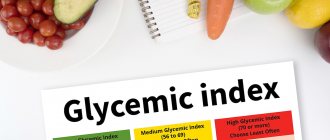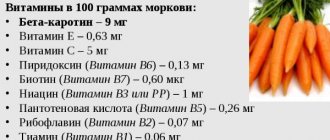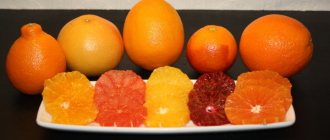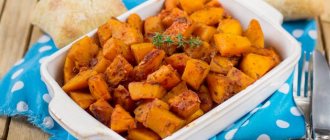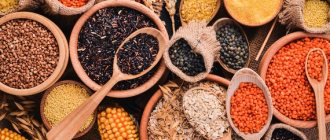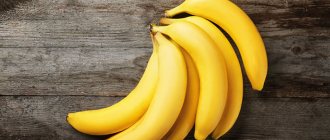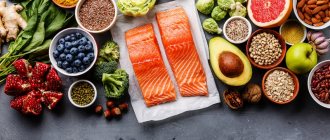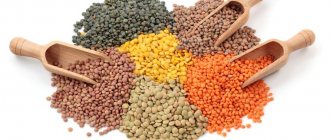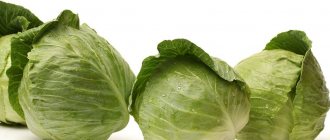We are what we eat. And most health problems are caused by poor nutrition. Take, for example, obesity and diabetes. These diseases go hand in hand. The first is a consequence of the uncontrolled absorption of all the most harmful, sweet and fatty foods, the inability to say to oneself “enough” and ignorance of the basic rules of creating a diet. And one of the factors influencing the occurrence of the second is a rapid increase in body weight. In this article we will tell you what the glycemic index of food is, explaining how it affects our well-being and figure.
Our additional services: Bioimpedance | Marutaka Massage | Pressotherapy | Ion-Detox
When health is at risk: a few facts
Under the definition, which all leading nutritionists talk about, is an indicator of the impact of the food we prepare or buy for ourselves on our blood sugar levels. It depends on the GI whether it goes off scale or remains within the normal range. Each product has its own number - from zero to one hundred. The higher it is, the faster food affects glucose levels, increasing it
Pure glucose has a glycemic index of 100. What does this mean? It gets into the blood instantly. Vegetables, fruits, semi-finished products, sweets, meat, fish, and pasta are compared with this indicator—let’s call it “the limit.” Everything that ends up on your table, and then into your stomach.
The news that there are foods with a low and a high glycemic index, and that the GI of foods has a direct impact on our health, has changed the position of nutritionists in relation to what diet is considered correct. Experts have made many discoveries. For example:
- Bread and potatoes can quickly raise blood glucose levels - just like a few pieces of refined sugar.
- Some foods that seem completely different have almost the same GI. Let's take donuts and watermelon. The index of the sweet delicacy that came to us straight from the confectionery shop is 76, and the largest false berry has a score of 75. Surprising, but true!
However, you should not judge the benefits or harms of a particular food by the glycemic index. If you do this, those same watermelons will be on the black list along with cakes and chips.
Not so simple. This figure alone cannot be blindly trusted. There is another indicator that helps to understand how high the glucose level will rise, and also how long it will last at our maximum level. We will tell you about it further.
High glycemic index foods:
High GI foods quickly saturate the blood with glucose, as a result of which the body quickly replenishes itself after exercise and strength exercises.
But if there are none, and you lead an inactive lifestyle, spare energy accumulates in the form of fat deposits. Long-term eating of such foods causes increased levels of insulin, which distributes excess sugar in the form of fat deposits evenly throughout the body and protects fat from a backlash. The result is obesity, diabetes, and cardiovascular disease. High glycemic index foods
| Product | GI |
| Beer | 110 |
| Dates | 103 |
| White bread | 100 |
| Glucose | 100 |
| Modified starch | 100 |
| White bread toast | 100 |
| Swede | 99 |
| Butter buns | 95 |
| Pancakes | 95 |
| Potatoes (baked) | 95 |
| Rice noodles | 95 |
| Canned apricots | 95 |
| baked potato | 95 |
| Fried potatoes | 95 |
| Potato casserole | 95 |
| Rice noodles | 92 |
| Canned apricots | 91 |
| Instant rice | 90 |
| Honey | 90 |
| Gluten-free white bread | 90 |
| White (sticky) rice | 90 |
| Instant porridge | 85 |
| Carrots (boiled or stewed) | 85 |
| Cornflakes | 85 |
| Mashed potatoes, boiled potatoes | 85 |
| Carrots (boiled or stewed) | 85 |
| Hamburger buns | 85 |
| Unsweetened popcorn | 85 |
| Rice pudding with milk | 85 |
| Mashed potatoes | 83 |
| Sports drinks (PowerAde, Gatorade) | 80 |
| Muesli with nuts and raisins | 80 |
| Cracker | 80 |
| Muesli with nuts and raisins | 80 |
| Sweet donut | 76 |
| Sweet pastries (waffles, donuts) | 75 |
| Pumpkin | 75 |
| Watermelon | 75 |
| Melon | 75 |
| Rice porridge with milk | 75 |
| French baguette | 75 |
| Rice porridge with milk | 75 |
| Lasagna (soft wheat) | 75 |
| Unsweetened waffles | 75 |
| Millet | 71 |
| Millet | 70 |
| Carrots (raw) | 70 |
| Milk chocolate | 70 |
| A pineapple | 70 |
| Dumplings | 70 |
| Soft wheat noodles | 70 |
| White rice | 70 |
| Potato chips | 70 |
| Couscous | 70 |
| Semolina | 70 |
| Chocolate bar (“Mars”, “Snickers”, “Twix”, etc.) | 70 |
| Sweet soda (Coca-Cola, Pepsi-Cola, etc.) | 70 |
| Croissant | 70 |
| Soft wheat noodles | 70 |
| Pearl barley | 70 |
| Risotto with white rice | 70 |
| Brown sugar | 70 |
| White sugar | 70 |
Health formula: not only GI
Another definition we'll talk about is GL or glycemic load. It is not so difficult to calculate: just multiply the GI index by the amount of carbohydrates contained in the product and divide the result by one hundred.
So, for donuts the load will be 29.5, and for watermelons - 5.1. This is what needed to be proven: with flour products we will receive several times more glucose than with one of our most favorite summer treats.
Why is this indicator needed? It becomes an excellent confirmation that it is necessary to take into account not only the glycemic index. After all, if we choose a product with a low GI, but high in carbohydrates, then we will gain weight twice as fast.
How to keep the situation under control? We offer you the following option: constantly monitor your GN, choose foods with a low index, or limit your carbohydrate intake.
At the same time, we cannot completely forget about these useful organic substances. Remember that there are two types: fast and slow. The former should be excluded from the diet, but the latter can be left - but in moderation.
The benefits of low GI foods for diabetes
Diagnosed diabetes mellitus, especially type 2, requires adherence to a certain diet, including only foods with a low glycemic index in the menu. This diet helps regulate blood sugar levels, thereby compensating for the disease.
Products with a certain index are divided into the following groups:
- Up to 55 units - this indicator corresponds to products with a low GI level. This group includes almost all vegetables and some fruits, as well as dishes containing high concentrations of proteins and fats.
- 56–69 units - some legumes, vegetables, fruits and grain cereals have an average GI value.
- Over 70 units – a high level of glycemic index is contained in products containing fast carbohydrates (sugar, confectionery and flour products made from premium flour).
Diet therapy for diabetes 2 occasionally, no more than 1–2 times a week, allows the inclusion of foods with an average GI in the diet. A properly composed menu of low-GI food provides the following opportunities:
- gradual release of glucose during digestion;
- controlling appetite;
- prevention of excess body weight gain;
- rational weight loss without stress for the body;
- prevention of diabetic complications.
A low GI diet can be easily varied. The presence of most of the usual foods in the diet, with only a slight correction, makes it balanced and high in calories, containing the necessary nutrients for the body.
Glycemic index and glycemic load. How to lose weight using the glycemic index?
Failure to follow the diet can lead to the following unwanted complications:
- sharp fluctuations in blood sugar levels with the development of hyperglycemia or hypoglycemia, up to a life-threatening coma;
- transition of type 2 diabetes mellitus to insulin-dependent;
- the appearance of cardiovascular failure with its further progression;
- decreased vision up to its loss due to destruction of the vascular network of the retina;
- development of diabetic foot;
- the appearance of renal failure.
Sometimes, with mild type 2 diabetes, only with the help of diet and physical activity can the glycemic level be adjusted to normal levels without the use of medications.
What's good and what's bad: low glycemic index nutrition
Nutritionists have divided GL levels into several categories:
- The optimal indicator is no more than 10.
- Average – over 11 and up to 19.
- High – more than 20.
The glycemic load per day should not exceed the norm - 100 units. This warning is true for a healthy person who takes care of himself and eats right.
However, both GBV and GI can be outsmarted. Why and how? The index is influenced by heat treatment - the form in which a particular product enters our stomach. And here's what you can do to help yourself get rid of extra numbers and excess weight:
- The more industrially processed, the higher the glycemic index. If you don’t want to gain new kilograms, and with them new diseases, give up processed foods and switch to natural foods. Example: in front of you is instant mashed potatoes and simple boiled potatoes. A semi-finished product has an index of 90, while something made at home has an index of 65. The difference is obvious.
- Culinary (heat) processing also affects GI, causing it to increase. So, stewed cabbage has an index of 15, and fresh cabbage has an index of 10. What to do? Is it really possible to give up the usual ways of preparing your favorite dishes and eat raw vegetables? If thermal exposure is unavoidable, keep it minimal. In boiled food, many valuable nutrients and organic compounds are destroyed - for example, vitamin C, fiber.
- Products that have a low glycemic index and contain a maximum of beneficial vitamins, minerals and amino acids - what are they? This is all that contains coarse fibers in large quantities. The more there are, the better for you and the lower the indicator.
- How to eat fruits and vegetables to retain their beneficial properties if heat treatment deprives them? Consume the gifts of nature along with the peel - it contains so much fiber, on which the GI depends.
- Another interesting fact: the more the product is crushed, the higher its glycemic index. For example, let’s take soft and fluffy buns made from white flour - fresh from the oven, as well as a tea loaf and bread made from wholemeal flour. The first indicator is 95, the second is 70, and the third is 50. Rice can be compared in the same way - polished and unpeeled (the first GI is 70, the second is 50). What can be concluded? If you want to maintain your health and figure, choose a product that has undergone gentle processing, or completely natural food - whole grain porridge, bran bread made from flour obtained after grinding grain once.
- Some interesting information about fruits: the more acidic they are, the lower the GI. It turns out that unripe apples are healthier than overripe ones.
How to reduce the indicator? You can use a little trick: prepare a dressing for salads from fresh vegetables or a spicy vinegar-based marinade.
Should the diet really only contain foods with a low glycemic index, and the rest should be prohibited? Don't go to extremes. When creating a menu for every day, do not exclude any dish, focusing only on GL or GI. It’s worth looking at the calorie content, because it is the energy value of the food we eat that determines whether we will gain weight or not. Don’t forget that your diet contains all the necessary vitamins, minerals, and amino acids.
Why then is the concept of glycemic index given? Knowing it, you can adjust and regulate the daily GL. Here are the main values used by nutritionists:
- The level we are used to is between 60 and 180.
- An indicator not exceeding 80 can be considered too low.
- The average number is from 80 to 119.
- Increased load – from 120.
If you suffer from excess weight or diabetes and are forced to monitor the amount of carbohydrates consumed and blood sugar levels, you need to create a daily diet so that the total GI does not exceed 100 units.
Difference between GI foods and diets
The glycemic index is determined for each food unit separately and reflects the rate of breakdown of carbohydrates with a subsequent increase in blood sugar. In practical dietetics, it is customary to distinguish between the GI of foods and the GI of the diet. In the glycemic index classification, there are 2 types.
| For food: | For diets: |
|
|
The diet is made up of several dishes, including a set of various food units with a certain GI indicator. The total glycemic index of the diet will be higher than that of individual foods.
This increase can be triggered by eating fruits, some berries or citrus fruits, as well as other foods that already have a GI of 55 or higher. When planning your diet, this factor must be taken into account.
For diabetics, a menu made up of various products should have a GI of 45 or lower (recommendation of the Glycemic Index Foundation). A low glycemic diet should be the goal of every diabetic.
This approach makes it possible to maintain blood glucose levels at optimal values, avoiding its sharp increase when eating. With this diet, the risk of developing diabetes complications is significantly reduced.
Glycemic index and calorie content of food: table
Below are the values for vegetables.
Compare them - this will help you choose the most useful and easy ones for a perfectly slim figure. Don’t forget about proper nutrition, monitor the GL and energy value of your meals - this will bring you closer to the desired volumes and help consolidate the result.
The lowest indicators are for vegetables that have not undergone heat treatment. Draw conclusions: plant foods are the basis of the diet, but the thermal effect should be gentle.
This far from complete table contains a list of foods with a low glycemic index (GI) for weight loss. However, you should not put this indicator at the forefront. Do not forget:
- The calorie content of what we eat is of decisive importance.
- Proper nutrition cannot be monotonous and meager (for example, only vegetables or fruits).
- The list is not given so that you limit yourself, but so that your diet is complete and your menu is varied and balanced.
What does the GI of foods depend on?
The glycemic index of foods is a variable value. Its level is influenced by the following factors:
- carbohydrate structure;
- fiber, protein, fat content;
- consistency of food;
- degree of thermal and culinary processing;
- rate of food absorption.
All these factors must be taken into account when creating a menu for patients with diabetes. A properly formulated diet should include:
- 10–35% proteins;
- 20–35% fat (vegetable origin);
- 45–65% carbohydrates (polysaccharides).
This ratio of BJU dishes in the menu will be optimal for diabetics; selected products with low and medium GI will slowly increase the concentration of glucose in the blood.
What determines the glycemic index of foods?
There are several factors that cause changes in the glycemic index of foods or dishes:
- degree of product fragmentation;
- processing and heat treatment of the product;
- dietary fiber content;
- degree of ripeness of fruits or vegetables;
- the type of carbohydrates present;
- presence of other nutrients
- meal preceding the consumption of a particular product.
An interesting fact is that the same product can have different IGs, depending on the above factors. That's why cooked carrots have a higher glycemic index (47) than the raw vegetable (16), and unripe bananas have a lower glycemic index (59) than their ripe counterparts (72). These differences even apply to regular and instant oat flour, which have a glycemic index difference of as much as 12 units. Thus, knowing the factors that influence IG shifts allows us to plan our meals more intelligently, from choosing the type of flour, judicious purchasing of vegetables and fruits, to the duration of cooking or baking.
Glycemic index table
In order to have an idea of the rate of breakdown of carbohydrates in a particular dish, a special table has been created, where each product has its own glycemic index value. It was created to provide information specifically for each food product, at what speed the body breaks down its carbohydrates into glucose.
This data is important for people who adhere to a properly balanced diet, as well as those suffering from diabetes. According to established data, tables with GI have approximate values, and the indicators themselves refer to one specific product without any thermal or mechanical treatment in its entirety. There are 3 groups of glycemic index foods:
- low (from 0 to 40);
- average (from 40-70);
- high (70 or more).
The table does not contain low-fat cheeses and dairy products, broths, or water. This is due, first of all, to the fact that their glycemic index is practically zero.
Low GI
| Product name | GI |
| Oysters, shrimp, mussels, soy sauce | 0 |
| Spices, seasonings | 5 |
| Cancers | 5 |
| Avocado | 10 |
| Peanut | 15 |
| Brussels sprouts | 15 |
| Broccoli | 15 |
| Mushrooms | 15 |
| Walnuts | 15 |
| Green bean | 15 |
| Ginger | 15 |
| Zucchini | 15 |
| Sauerkraut | 15 |
| Cauliflower | 15 |
| Pine nuts | 15 |
| Red bell pepper | 15 |
| Onion | 15 |
| Hazelnuts | 15 |
| Olives | 15 |
| Almond | 15 |
| cucumbers | 15 |
| Radish | 15 |
| Rhubarb | 15 |
| Leaf salad | 15 |
| Celery | 15 |
| Black currant | 15 |
| Dill | 15 |
| Pistachios | 15 |
| Hazelnut | 15 |
| Spinach | 15 |
| Bitter chocolate with cocoa content less than 85% | 20 |
| Yogurt not flavored | 20 |
| Lemon juice | 20 |
| Cocoa powder | 20 |
| Barbados cherry | 20 |
| Eggplant | 20 |
| Artichoke | 20 |
| Peas | 25 |
| Blackberry | 25 |
| Strawberries | 25 |
| Gooseberry | 25 |
| Strawberry | 25 |
| Raspberries | 25 |
| Beans | 25 |
| Red currants | 25 |
| Blueberry | 25 |
| Cherries | 25 |
| Barley grits | 25 |
| Lentils | 30 |
| Garlic | 30 |
| Beet | 30 |
| Turnip | 30 |
| Tomatoes | 30 |
| Pomelo | 30 |
| Carrot | 30 |
| Milk | 30 |
| Marmalade | 30 |
| passion fruit | 30 |
| Tangerines | 30 |
| Dried apricots | 30 |
| Pears | 30 |
| Grapefruit | 30 |
| Apricots | 35 |
| Oranges | 35 |
| Quince | 35 |
| Pomegranate | 35 |
| Mustard | 35 |
| Yeast | 35 |
| Green pea | 35 |
| Sunflower grains | 35 |
| Yogurt | 35 |
| Celery root | 35 |
| Sesame | 35 |
| Corn | 35 |
| Poppy | 35 |
| Nectarine | 35 |
| Peaches | 35 |
| Wild rice | 35 |
| Sunflower seeds | 35 |
| Plums | 35 |
| Fructose ice cream | 35 |
| Tomato juice | 35 |
| Canned peas | 35 |
| Red and black beans | 35 |
| Whole grain and sprouted grain bread | 35 |
| Apple | 35 |
Average GI
| Product name | GI |
| Dry beans | 40 |
| Buckwheat | 40 |
| carrot juice | 40 |
| Cereals | 40 |
| Spaghetti made from wheat flour | 40 |
| Chicory | 40 |
| Bananas | 45 |
| Grape | 45 |
| Vermicelli | 45 |
| Grapefruit juice | 45 |
| Jam | 45 |
| Coconut | 45 |
| Cranberry | 45 |
| Bread | 45 |
| A pineapple | 50 |
| Jam | 50 |
| Figs | 50 |
| Kiwi | 50 |
| Crab sticks | 50 |
| Orange juice | 50 |
| Mango | 50 |
| Durum pasta | 50 |
| Muesli | 50 |
| Canned peaches | 50 |
| Jam | 50 |
| Unpeeled rice | 50 |
| Ground pear | 50 |
| Blueberry juice | 50 |
| Apple juice | 50 |
| Persimmon | 50 |
| Canned peaches | 55 |
| Rolls and sushi | 55 |
| Mustard | 55 |
| Ketchup | 55 |
| Grape juice | 55 |
| Canned corn | 55 |
| Melon | 60 |
| Papaya | 60 |
| Cocoa with added sugar | 60 |
| Oatmeal | 60 |
| Ice cream | 60 |
| Long grain rice | 60 |
| Industrial mayonnaise | 60 |
| Melon | 60 |
| Lasagna | 60 |
| Wheat flour pancakes | 60 |
| Pizza with cheese and tomatoes | 60 |
| Pasta with cheese | 65 |
| Boiled jacket potatoes | 65 |
| Sorbet | 65 |
| Rye bread | 65 |
| Canned vegetables | 65 |
| Maple syrup | 65 |
| Raisin | 65 |
| Muesli with sugar | 65 |
| Marmalade | 65 |
| Boiled beets | 65 |
| Yeast black bread | 65 |
| Jam | 65 |
High GI
| Products name | GI |
| Wheat flour | 70 |
| Sugar | 70 |
| Semolina | 70 |
| Potato chips | 70 |
| Croissant | 70 |
| Pearl barley | 70 |
| Chocolate bars (Mars, Twix, Snickers, etc.) | 70 |
| Sweet sparkling water | 70 |
| Milk chocolate | 70 |
| Millet | 70 |
| Unsweetened waffles | 75 |
| Rice porridge with milk and sugar | 75 |
| Watermelon | 75 |
| French baguette bread | 75 |
| Zucchini | 75 |
| Pumpkin | 75 |
| Cornflakes | 75 |
| Sweet donut | 75 |
| Cracker | 80 |
| Mashed potatoes | 80 |
| Muesli with raisins and nuts | 80 |
| Unsweetened popcorn | 85 |
| Hamburger buns | 85 |
| Cornflakes | 85 |
| Rice pudding with milk | 85 |
| Boiled carrots | 85 |
| Instant mashed potatoes | 85 |
| Canned apricots | 90 |
| Rice noodles | 90 |
| White bread | 90 |
| Fried potatoes | 95 |
| Butter buns | 95 |
| baked potato | 95 |
| Potato casserole | 95 |
| Toast made from white bread | 100 |
| Glucose | 100 |
| Modified starch | 100 |
| Dates | 105 |
| Beer drinks | 110 |
